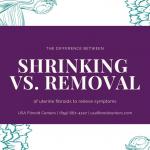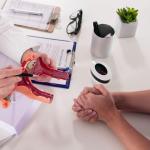
Uterine Fibroid Embolization (UFE) or fibroid embolization, is a minimally invasive, outpatient treatment for fibroids. Unlike hysterectomy (a surgery that treats fibroids through the complete removal of the uterus), UFE uses a non-surgical technique to block blood flow to fibroids. This causes the fibroids to shrink and wither away. Over time, any treated fibroids are naturally reabsorbed by the body. UFE can treat multiple fibroid sizes and locations. Once you’ve decided that UFE is the right fit for you and your doctor confirms candidacy, preparation for UFE can helpful for the recovery.
Uterine Fibroid Embolization Recovery
Immediate Recovery
After undergoing UFE, it’s normal to experience cramping, fatigue, and mild discomfort as your body begins to heal. These symptoms are typically well-managed with prescribed medications. Carefully following your doctor’s post-procedure instructions is essential for a smooth recovery during this initial phase.
Potential Post-Procedure Symptoms:
- Cramping: Similar to menstrual cramps.
- Fatigue: Feeling tired or low on energy.
- Nausea: Some women report mild nausea for several days following uterine fibroid embolization. If this occurs, try eating bland foods and drinking plenty of fluids. If your nausea causes undue distress or does not resolve within a few days, talk to your doctor about anti-nausea medication
- Fever: It is not uncommon to have a mild fever (below 101 degrees) after UFE. If this occurs, follow your doctor’s instructions on how to reduce fever.
- Period Changes: Period changes are normal after Uterine Fibroid Embolization (UFE) as your body adjusts to the treatment. These changes occur because UFE reduces the blood supply to the fibroids, causing them to shrink, which can impact your menstrual cycle
Management:
- Use prescribed pain medications as directed.
- Stay hydrated and rest to support recovery.
If you have any questions during your recovery, contact us. We can provide further instructions at that time.
Returning Home After UFE
Upon discharge, you’ll receive detailed instructions to help you recover effectively at home. These include guidelines on pain management, activity levels, and when to seek medical attention if needed.
Key Discharge Instructions:
- Follow Medical Guidance: Adhere closely to your doctor’s recommendations, including any restrictions on lifting or physical activity. Avoid lifting heavy objects (over 10 pounds) for the first 48 hours and refrain from intense exercise for at least one week.
- Gradual Return to Activities: Slowly ease back into normal routines, with most patients resuming full activity levels within two weeks.
Work and Rest:
Plan for at least a week or two off from work to allow your body to recover fully, depending on the nature of your job and how you feel.
Pain Management after UFE
Prescribed Medications:
- Your doctor will likely prescribe medication to help manage cramping and discomfort.
- Over-the-counter options, such as ibuprofen, may also be recommended for mild symptoms.
Using Pain Relief Effectively:
- Take medications as directed to stay ahead of the pain.
- Contact your doctor if pain persists, worsens, or is not controlled by medication.
When to Call Your Doctor
Reach out to your healthcare provider if you experience any of the following:
- Severe or persistent pain that doesn’t improve with medication.
- Heavy bleeding or unusual discharge.
- Signs of infection, such as fever, redness, or swelling at the catheter site.
How Long is UFE Recovery?
First Few Days:
You may experience mild cramping and fatigue during the first 48 hours, but these symptoms should gradually subside. It’s important to avoid strenuous activities during this time.
2-4 Weeks Post-UFE Procedure:
Most individuals begin to feel significantly better within a week or two and are able to return to normal daily activities. Mild discomfort may still occur but will continue to diminish.
8–14 Days:
Many patients fully resume regular activities during this period, enjoying the benefits of reduced fibroid symptoms and improved quality of life.
4-6 Weeks Post-UFE:
At this stage, most patients feel a significant boost in their energy levels. Fatigue and discomfort usually subside, making it easier to return to a fully active lifestyle. Symptoms like heavy bleeding and pelvic discomfort continue to improve as fibroids shrink further. This is also when you can safely resume regular exercise routines and long-distance travel. Whether it’s hitting the gym, going for a run, or planning a vacation, most patients feel confident enough to enjoy these activities by the four-to-six-week mark.
When Can You Travel After UFE?
Most patients can consider traveling after Uterine Fibroid Embolization (UFE) depending on their recovery progress. During the first week, rest and short walks are prioritized, so long trips are not recommended. By 1–2 weeks, many feel well enough for short local travel, ensuring they take breaks to stretch and move around to promote circulation. Long-distance travel, including flights, is generally safe 2–4 weeks post-procedure, with precautions such as wearing compression socks, staying hydrated, and moving around during flights or extended car rides to prevent blood clots. By 4–6 weeks, most individuals are fully recovered and can enjoy all types of travel comfortably. It’s always best to consult your doctor before making travel plans to ensure you’re cleared for extended activity and address any lingering symptoms.
What Not to Do After Fibroid Embolization?
Along with following our tips for self-care while recovering from UFE, avoid certain activities to support a full and rapid recovery.
To aid your UFE recovery:
- Do not lift anything heavy (over 10 lbs) during the first week of your recovery
- Do not shower during the first 24 hours
- Do not bathe, swim, or immerse yourself in water for the first 5 days
- Do not participate in strenuous activity until you receive medical clearance
Tips for Taking Care of Yourself at Home After UFE for Recovery
The days and weeks after UFE can be a time to prioritize rest, self-care, and progress. This is your chance to focus on you—to celebrate the positive changes ahead and take simple, effective steps to support your healing. From managing discomfort to reintroducing activities at your own pace, every small action you take brings you closer to a full recovery and a life free from fibroid symptoms.
At home UFE Recovery Tips:
- Wear loose, comfortable clothing
- Eat a normal diet when possible
- If you experience nausea, choose bland foods like rice, toast, and yogurt
- Drink plenty of fluids
- Take medications exactly as prescribed
- Do not drive while taking prescription pain relievers
- Get lots of rest
- Use a heating pad to help relieve cramps
- Take short, daily walks
Although it may be challenging to take the necessary time to recover, it’s important to care for yourself after UFE to minimize treatment side effects and avoid complications. In most cases, planning can help make this possible.
Schedule a Consultation Today
At USA Fibroid Centers, our leading fibroid specialists perform uterine fibroid embolization at dozens of locations across the country. If you have questions about health insurance coverage, go ahead and give us a call at 855.615.2555. We work closely with most major insurance plans to maximize benefits. When you’re ready to meet with one of our specialists and learn more about embolization for fibroids, schedule an appointment online.



